How Karol G went from a Latin music star to a fashion icon
- Oops!Something went wrong.Please try again later.
Editor’s Note: This article was originally published by The Business of Fashion, an editorial partner of CNN Style.
(CNN) — In the ad campaign for Loewe’s latest “Paula’s Ibiza” collection, the singer Karol G is seen emerging from the sea in a white slip dress, waves reflected in sunglasses that set off her (then) flame-red hair as she gazes into the horizon. The image, captured on Colombia’s Caribbean coast, has a mythical quality that somehow reveals the pensive songwriter behind the high-octane performer. Jonathan Anderson, Loewe’s creative director, wanted it shot in the musician’s home country, she said, to capture “the entire Karol G vibe.”
It is a vibe that has spread like wildfire in the last year. In February, Karol’s fourth studio album, “Mañana Será Bonito” (Tomorrow Will Be Beautiful), became the first Spanish-language album by a woman to debut at number one on the US Billboard 200 chart. Last month, she won an MTV Video Music Award for her collaboration with Shakira for their track “TQG.” Today, she is the female artist with the most Spanish songs on the Billboard Hot 100.
The new queen of reggaeton — a dance-ready style of music dominating the airwaves with its mix of reggae, rap and dembow beats infused with pop — Karol G is a household name across much of Latin America. But some of her biggest hits — including “Provenza” and “Tusa,” a duet with Nicki Minaj — have helped the genre strike a chord with audiences all over the world, cementing her newfound status as a global pop sensation.
And in navigating her way through the notoriously tricky music industry, Karol has managed to cultivate an image and a sphere of influence that have been noticed by forward-thinking brands in an equally tricky industry: fashion.
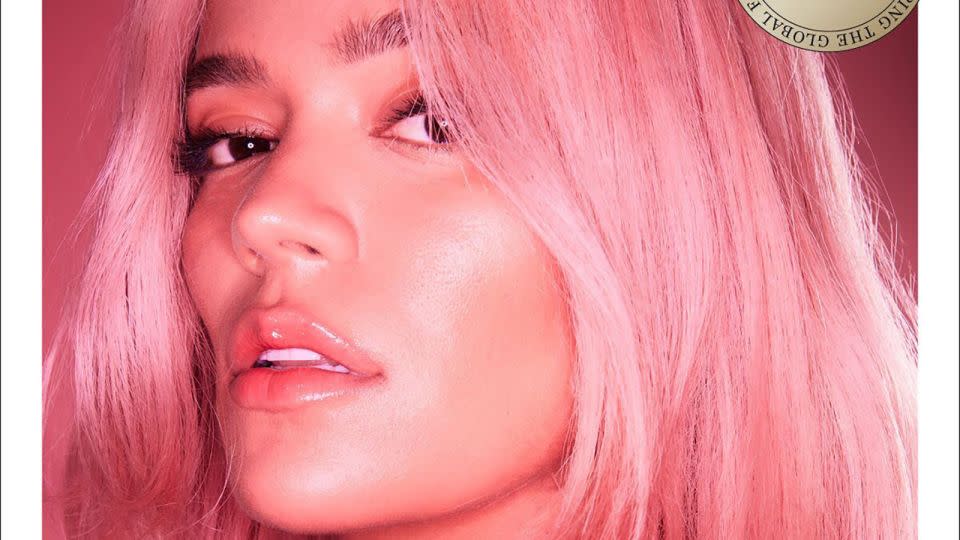
“Karol G is one of the biggest stars in contemporary Latin music and her bold, eye-catching style is a major part of her persona,” said Charlie Smith, chief marketing and communications officer at Loewe, which was the first luxury brand to cast her as a campaign model. “She has a huge global following thanks to the way she brings her own twist to reggaeton and has brought the style of music to new audiences around the world.”
Loewe’s decision to tap the reggaeton star appears to have paid off. On Instagram, the response to Karol’s post of the campaign clocked up more than three million likes and $1.2 million in media impact value (MIV) for the brand, according to Launchmetrics, a data analytics firm.
The campaign, which was revealed in April, couldn’t have come at a better moment for the LVMH-owned brand: Karol G may have been relatively unknown to the wider fashion establishment but her music career was about to go into overdrive, fueled by an increasingly passionate and devoted fanbase.
After a June televised performance for the “Today Show” outside New York City’s Rockefeller Center, producers of the show revealed that the crowds for Karol’s appearance swelled to a size larger than any other in memory, including those for Latin music legend Ricky Martin’s landmark 1999 performance. Two months later, Billboard announced that Karol made history as the female with the most entries on its Hot Latin Songs chart, a ranking which has been around for more than three decades. No wonder “Rolling Stone” magazine gave her its September cover.
But if, as the magazine’s strapline suggests, Karol does now feel “fearless and free” in the music industry that hasn’t always embraced her, then her feelings for the fashion industry have yet to follow.
The making of a muse
“I’ve never been ‘best friends with fashion,’ so to speak,” confided Karol, expressing as much surprise as delight that her big break in fashion would come from a highly conceptual designer like Anderson, and a luxury brand at the scale of Loewe. “Fashion can be awkward. My style just goes with the flow.”
The pairing isn’t entirely obvious. In recent years, Loewe has been rejuvenated by Anderson’s surrealist, craft-infused approach, pushing annual sales within striking distance of €2 billion ($2.1 billion), according to market sources. But it remains one of Spain’s most iconic heritage brands, having traded on its elite status and discreetly opulent aesthetic since 1846. Karol G’s image is far more exuberant and accessible.
“Before that, I felt like no one saw me as a fashion-related figure because I never got clothing from brands, and when we approached them, it didn’t work out,” recalled Karol, explaining that she usually had to buy what she wanted at retailers, instead of having brands offer to lend the latest season’s pieces — a publicity perk that other musicians of her caliber readily enjoyed. “It took me a long time to experience that.”
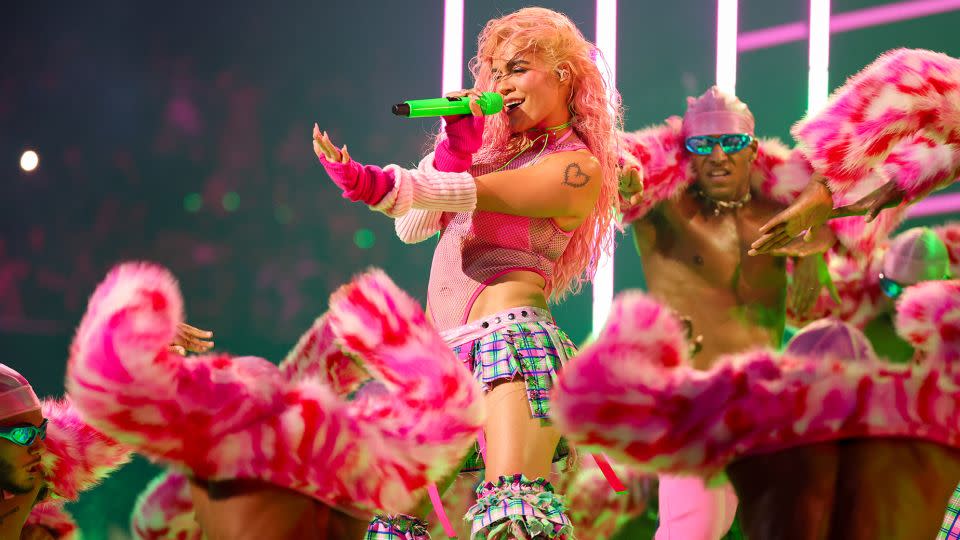
But if Karol still sees herself as a fashion outsider, her power as an influencer has become clear to savvy fashion insiders. A ranking of the top 100 Instagram accounts compiled by SocialBook, a company connecting creators and brands through influencer marketing, shows that Karol G’s engagement rates are significantly higher than some of her contemporaries.
With 66 million followers on the platform, Karol G ranks 70th in terms of follower count but 6th when it comes to engagement rates. In early October, her 60-day engagement rate was higher than that of K-pop boy band BTS, whose members have numerous luxury brand ambassadorships, and Hollywood star Zendaya.
To put this into context, Kim Kardashian has more than five times the followers as Karol G, but Karol’s 5.8 percent engagement rate dwarfs Kardashian’s 0.4 percent rate over the same period.
“A good or impressive engagement rate is anything close to or above 5 percent,” said Julian Martinez, creative director at SocialBook.
“A high engagement rate means you are doing something right with your audience and captivating their emotions one way or another,” Martinez added. “There are many factors and variables present (so) it’s hard to isolate the exact cause. However, whatever (Karol G) is doing with her posts and content, she’s doing a great job.”
Celebrity marketing can pay dividends in brand awareness and affinity, but it can also directly drive sales of specific items when fans are compelled to imitate their idol’s style. “Karol G Closet” is just one of many social media accounts that chronicles Karol’s wardrobe like a shopping guide, complete with product shots and prices for the Balenciaga shoes, Miaou corsets and Miu Miu skirts she has been spotted wearing.
At last year’s Coachella, for example, where she wore a Roberto Cavalli costume to sing a medley of classics by Latin music artists, a wave of color emerged from the crowd as throngs of fans paid tribute to the singer’s “blue era” hair by wearing wigs of the same colour. “That was a surprise,” she said.
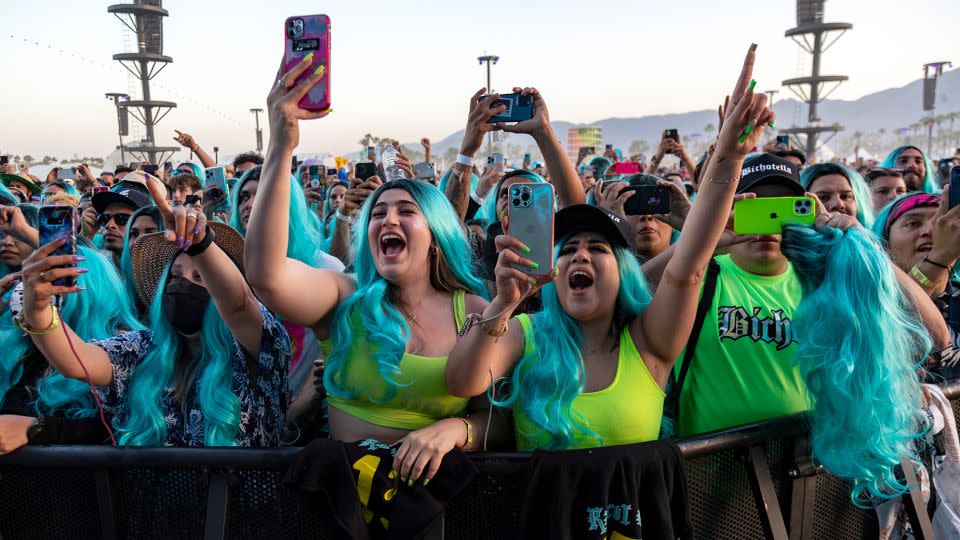
Brands almost never release figures to prove that a campaign model was a good return on investment, and rarely use that sort of language when they do comment. Loewe is no different. But the label’s enthusiasm for its Karol G campaign a half-year after its release is telling, nonetheless. “The collaboration was extremely successful,” said Loewe’s Smith, citing the 45 million impressions her campaign post yielded on social media and the commercial success of the sunglasses she wore in the campaign.
Predictably, the Loewe partnership brought Karol to the attention of other brands. “Working with Loewe opened the door to everything else happening now. After that, we got invitations from many other designers, fashion magazines and runway shows,” she said.
In June, Karol was invited by Jacquemus to sit front row at the French brand’s Palace of Versailles show wearing an off-the shoulder gown. “That made a lot of noise,” she recalled. At the Los Angeles “Barbie” premiere — the movie’s soundtrack includes her track “Watati” — a month later, Emilio Pucci dressed her in a halter-neck crop-top and maxi skirt for the pink carpet.
“You know, I never thought that being faithful to who I was — not following what’s in or out of fashion and not having to change myself to get there — would bring me such a platform,” said Karol, noting that most of her recent fashion industry encounters have helped her stay true to her style, but do so in a way that makes it look “more elevated.”
Her style has definitely undergone an evolution over the past seven years she’s been in the public eye. Streetwear wardrobe staples like joggers, trainers and caps still make an occasional appearance but now they’re coordinated with embellished tops, lingerie-inspired loungewear or sultry frocks. Vetements and Rick Owens are among the labels that pique her interest these days, but she won’t lock herself into any look that’s reliant on specific brands just yet. “I want to keep experimenting,” she said.
That doesn’t mean she’s not conscious of the need to paint her image with a degree of consistency. To that end, she’s made colorful hair a trademark, often alternating between pastels and jewel tones. She keeps returning to a few style themes too, a tactic that makes it clear she is the one wearing the brand — not the brand wearing her.
Putting the fashion world on notice
Karol has described her emerging signature look as a “mermaid (who’s) a tomboy at heart.” That duality looms large in the outfits she wore for “Tusa,” for example. The video for that song framed her wearing an ethereal floor-length gown next to mythical creatures like a Pegasus; her performance of the song at the Latin Grammys saw her command the stage in bejeweled off-road motorcycle racing trousers.
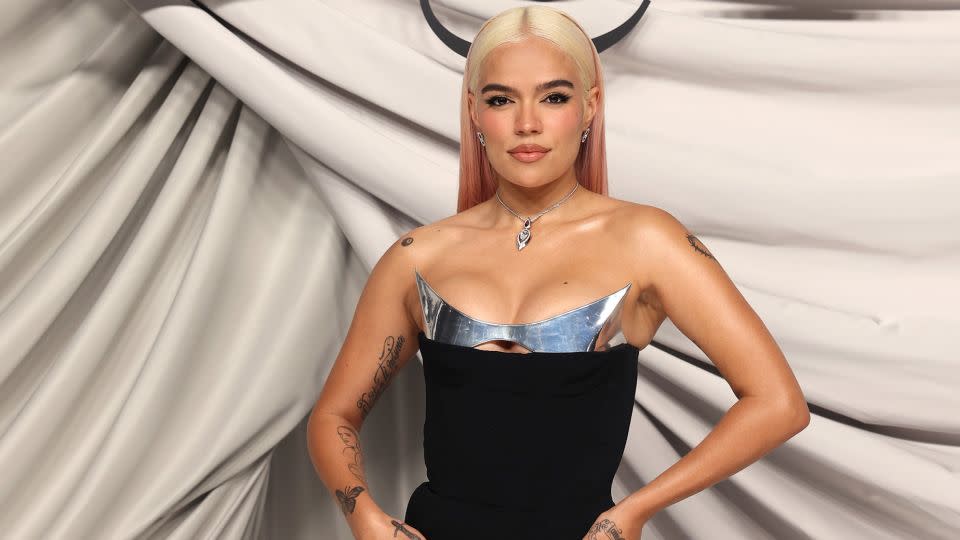
But no matter which direction the winds of fashion may be blowing, she said, some items are sacred — like hoop earrings, which she insists she will never abandon because they symbolize her roots in Colombia’s urban street culture. “I won’t stop doing something that truly represents me,” she said. “I’m very careful about that.”
Perhaps it’s down to the fact that she is still in awe of her own successes, but Karol is prone to a bit of gushing, albeit in a tone that sounds more humble than sycophantic. It makes sense that she’s “hugely grateful” to Anderson for the Loewe gig. Being associated with the elite, high-concept luxury brand could help set her apart from other female reggaeton stars in the eyes of the fashion industry.
Why then did it take high fashion so long to notice her?
It’s true that her recent ascent has been steeper than most but, by 2022, Karol G had already secured her third consecutive year as the most-streamed Latin American female worldwide on Spotify. She has been huge in the region — where most big luxury brands have stores in at least a few major markets — for years. And beyond the US and Spain, where she’s been well-known for a while, her music has been streamed in the millions in countries like France, Italy, Germany and Canada, according to Maykol Sanchez, Spotify’s head of artists and label partnerships for the Latin America and US Latin markets.
One reason for the lag in recognition is that, until the 2020s, big brands were mostly focused on male musicians who traditionally dominated the reggaeton genre. Daddy Yankee’s partnership with Reebok and Don Omar’s with Umbro set an early precedent. By the time Karol G entered the scene in a big way, fashion, luxury and sportswear giants were still warming up to her male counterparts. In recent years, Maluma teamed up with Dolce & Gabbana and Balmain, J Balvin with Nike and Guess, Bad Bunny with Jacquemus and Adidas, and Nicky Jam with Hublot.
Ivy Queen, often credited as the original reggaeton queen, was a notable exception in those early male-dominated years of the genre, capturing attention with her female empowerment anthems. But it wasn’t until after the male wave of partnerships that women began landing global fashion and beauty contracts. Trailblazers in the broader Latin music scene like Jennifer Lopez and Shakira — who last year fronted a holiday campaign for Burberry — had laid the groundwork for them.
Anitta, Brazil’s funk carioca pop star who dabbles in reggaeton in both Portuguese and Spanish, has starred in campaigns for Levi’s and Dolce & Gabbana, among others. Barcelona native Rosalía, whose musical versatility has made some of her hits reggaeton chart toppers, became the face of Acne Studios last year, while genre-defying Mexican-American artist Becky G — who recorded the hit “Mamiii” with Karol — has collaborated with Pretty Little Thing. Karol herself scored a couple collaborations with brands before Loewe, notably Kappa and Crocs. But even these early movers were a bit late to the reggaeton party.
The origins of reggaeton can be traced back to Panama in the 1980s as a form of reggae in Spanish, where the genre drew musical inspiration from Jamaica before evolving in Puerto Rico. It blossomed in the 1990s and early 2000s, as it blended with American hip-hop, Dominican dembow and other Caribbean musical genres rooted in the African diaspora. Many of its early artists took style cues from US rappers of the time, albeit with a distinctive Latin streetwear edge.
In the 2010s, reggaeton found resonance in Karol G’s hometown of Medellín, Colombia, and the city soon became a creative capital for the scene. In 2017, her debut album, “Unstoppable,” co-produced with longtime friend and collaborator Ovy, emerged as a sensation. One track, “Ahora Me Llama” (Now He Calls Me), which featured the then-rising Puerto Rican rapper Bad Bunny, catapulted her to stardom across Latin America and in communities in the US, where nearly one-in-five people are of Latin American heritage, according to the Pew Research Center.
As some artists distanced themselves from reggaeton’s heavier rap origins and industrial clanks, a more commercial and melodic sound started gaining traction in cities like Miami, Mexico City and even as far afield as Buenos Aires and Santiago, Chile, where local musicians put their own spin on it. The once-underground genre had gone mainstream and so too had Karol G.
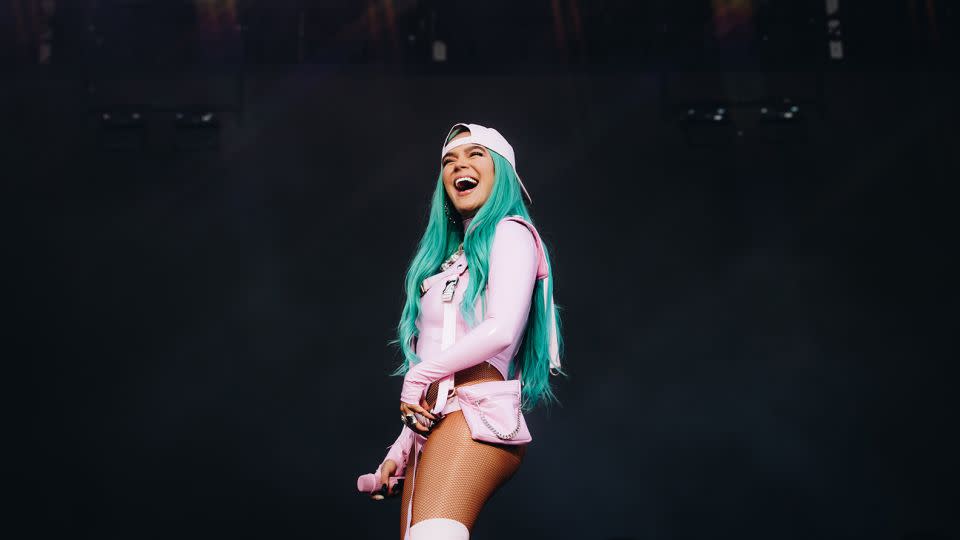
“Karol was booming after the pandemic hit. Her music was all over the radio stations here in Mexico. She had already taken off in our world, but [we knew] she was about to explode globally… so we wanted her,” says Karla Martínez, head of content for Vogue Mexico and Latin America, which featured her on the cover of the magazine early last year.
Today, reggaeton’s reach goes much further than its strongholds in Latin America, North America and Europe. Not only have record labels in Dubai opened Latin music divisions for reggaeton artists to tap Middle Eastern markets but nightclubs in Asian cities like Singapore now promote reggaeton dance nights and new musical hybrids fusing local genres with reggaeton can be heard on radio stations around the world, including African cities like Nairobi.
But the increasingly global appeal of artists like Karol G is not just a product of reggaeton. It is down to the rise of Spanish-language music more broadly. According to data from Spotify, Latin music streams have surged by nearly 170 percent worldwide over the past five years, with the category’s presence in the Spotify Global Top 50 witnessing a remarkable 90 percent growth.
“There’s been an explosion of Latin music all around the world, led by reggaeton, but it’s all different genres,” said Colombia-born Leila Cobo, Billboard’s chief content officer for Latin and Español, adding that it has been bolstered by music streaming services reshaping a market where “there aren’t as many gatekeepers as before.”
Uplifting culture — in style and song
“The music itself is more professional and better produced now too,” Cobo added. “Audiences react to the rhythm, even if they don’t speak the language. People aren’t as fixated on that anymore.”
Indeed, it is the shift in attitudes toward language that appears to have helped Karol G secure the Loewe deal. “Jonathan (Anderson) told me that, even though he didn’t understand what my lyrics were saying, that the music had a quality that just made him feel good,” Karol said.
Born Carolina Giraldo Navarro, Karol auditioned for Colombia’s “X Factor” as a 14-year-old but didn’t get far. During her teens, she sang at quinceañera coming-of-age parties alongside J Balvin before either made it big. She spent years gigging before signing with a Puerto Rican label that brought few successes. At a low point, she relocated to New York and nearly abandoned her music career aspirations.
“Karol worked hard,” said Cobo, noting that now, at age 32, she’s mature and has built her success from the ground up. “She has remained grounded throughout her career, openly discussing her struggles. I think that women see her and say, ‘There is a superstar who is like me.’”
“Besides, Karol’s not just a reggaeton artist anymore. She’s become a pop artist,” she added.
Being an ambassador of Latin American music and culture doesn’t come without pressure. Although Karol has called herself a “bichota” — a gendered riff on the Puerto Rican slang for a “big shot” that she reinterpreted as a daring, empowered “berraca” (badass) woman in her song of the same title — she readily confesses her insecurities.
“It scares me to think tomorrow I could make a mistake, and everything could turn against me,” she said, before hastening to add, “but I can’t let that dominate my focus.”
Karol explained that since the album “Mañana Sera Bonito,” she’s been more transparent about her life, including intimate topics like sexuality and family.
“I believe that a big part of the connection I have with my audience has been realness, like showing my life without filters,” she said. “I’ve been open and exposed. I haven’t tried to hide it in any way. I’m looking for ways to, I don’t know, internalize it all and say, ‘this is my moment, this is how I am, look at me.’”
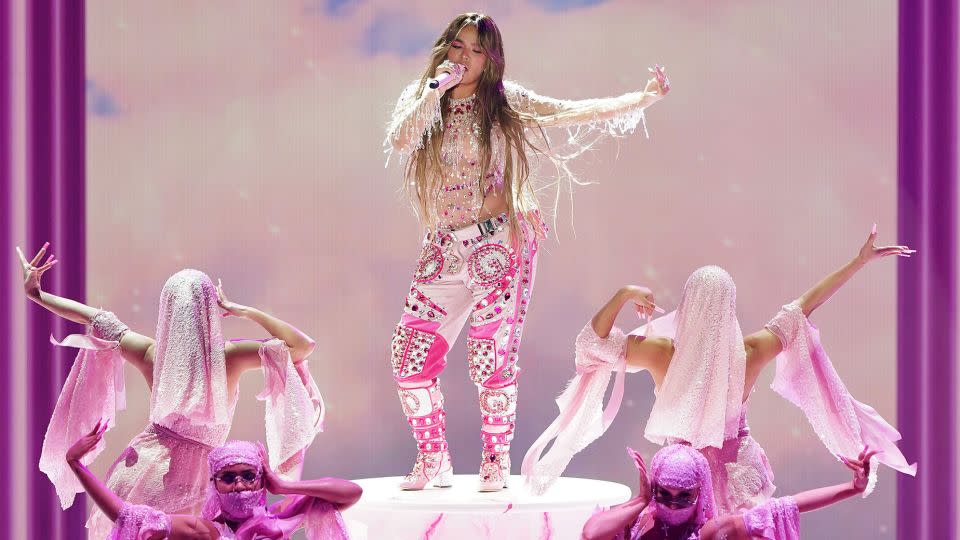
It’s true that Karol admits the kind of things that others in her position might try to hide, even comparatively trivial episodes like how daunting she finds it to navigate the fashion industry’s glamorous events. “I feel a bit out of my comfort zone there. When I see celebrities and artists (in those situations),” she explained. “There’s a certain etiquette. I don’t know how to stand, what to say, how to speak, but at the end of the day, I try to relax and enjoy the experience.”
But it’s precisely this raw, unpretentious charm that seems to make her alluring to fans and collaborators alike.
“She’s an artist who has become a role model for millions and not been afraid to show her vulnerabilities through her music,” said Nina García, editor-in-chief of the American edition of Elle, explaining that the decision to feature her on the magazine’s cover was a “no-brainer.”
“Her message of a better day and a beautiful tomorrow has become crucial in our fragmented, often strained world,” García observed. “And her success speaks for itself.”
The commercial pay-off for the magazine “exceeded expectations,” García said. “We thought this cover would be popular, but its reach blew us away, especially on social media. Her fans showed their support (and) it was quite amazing.”
As her profile grows, Karol is increasingly aware that her ability to attract top-tier fashion partners from Europe and the US is what helps give her the platform to support designers from Latin America and the diaspora.
“Colombia has globally recognized designers and I’ve had the chance to see the incredible talent there first-hand at Colombiamoda,” Karol said of Colombia’s fashion week. “But what might surprise you is that many of the things we wear are from small, independent designers that don’t have that much recognition,” says Karol.
“For instance, when I’m on stage, I work with the same people from Medellín who make my shoes (and) it’s been lovely to introduce the work of these Colombian artisans to stylists like Brett Alan Nelson and to connect them,” Karol said. “But I’ve been thinking about it lately and I think I can (do more) to help take their work to the next level.”
Her access to Colombia’s dynamic textile and garment manufacturing industry leads to another question: what about future business opportunities beyond modeling-based partnerships? Does she harbor any ambition to emulate other pop stars turned fashion entrepreneurs by co-designing a capsule collection or launching her own brand?
“I’m exploring how to expand my brand now, actually. I want to ensure that even if I retire from music someday, my name remains relevant and alive in other areas,” she said.
“But any brand that’s associated with Karol G has to be offering something that I can offer to my people that’s genuinely good, positive, and helpful,” she said. “Then I’d be eager to share it with everyone.”
This article was originally published by The Business of Fashion, an editorial partner of CNN Style. Read more stories from The Business of Fashion here.
For more CNN news and newsletters create an account at CNN.com

